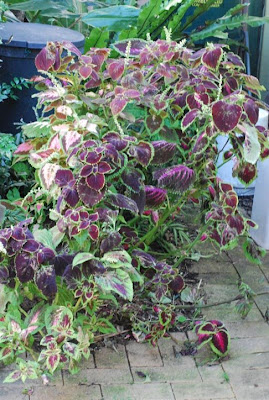What to do with a dark and shady corner? Last summer I discovered the answer was "sprinkle around some coleus seed" and it produced a beautifully colourful result. And I'm doing it again this year. Just sowed the seed a few weeks back, and the first coleus babies are up this morning.
 This is what I enjoyed last summer. One packet of Mr Fothergill's coleus seeds turned into an incredible array of leaf patterns and colours.
This is what I enjoyed last summer. One packet of Mr Fothergill's coleus seeds turned into an incredible array of leaf patterns and colours. Pulling back a few more feet shows the 'corner' in Coleus Corner. It's just outside the door to Pam's studio. Sunshine rarely makes it down here, even in summer, as it's also under the shade of an olive tree. I sowed the seed late-ish last year, and this is how the coleus looked from late December through to late March.
Pulling back a few more feet shows the 'corner' in Coleus Corner. It's just outside the door to Pam's studio. Sunshine rarely makes it down here, even in summer, as it's also under the shade of an olive tree. I sowed the seed late-ish last year, and this is how the coleus looked from late December through to late March. By May the plants had grown taller, stragglier and that tropical carnival of colour had taken on the seedy, dishevelled look of a drunk with a morning-after hangover. Oh well, it is temperate Sydney, not tropical Cairns, and it was good while it lasted.
By May the plants had grown taller, stragglier and that tropical carnival of colour had taken on the seedy, dishevelled look of a drunk with a morning-after hangover. Oh well, it is temperate Sydney, not tropical Cairns, and it was good while it lasted. And so I launched into my completely ill-fated attempt at a cutback in late winter, which merely finished off what was left, rather than prompting a revival. Had my doubts it would work, anyway, I now say with 20:20 hindsight.
And so I launched into my completely ill-fated attempt at a cutback in late winter, which merely finished off what was left, rather than prompting a revival. Had my doubts it would work, anyway, I now say with 20:20 hindsight. So, a few weeks back I invested the huge sum of $2.95 in another packet of coleus seed and here's the most advanced bub. Interestingly, all my coleus babies were this colour at this stage last year. It was much later that they took on their various bright colours.
So, a few weeks back I invested the huge sum of $2.95 in another packet of coleus seed and here's the most advanced bub. Interestingly, all my coleus babies were this colour at this stage last year. It was much later that they took on their various bright colours. There is one survivor from last year, Mr Speckled coleus, on the left here. He was the only one not grown from seed – he was given to me by a friend later on once the coleus patch had taken shape. Mr Speckled looks like he's ready to grow on this spring, and with his roots reaching into the compost bin against which he's planted, maybe that's the secret to coleus survival in Sydney winters – lots and lots of compost and other organic matter. I'll try that this year with the newly sown patch and see what happens.
There is one survivor from last year, Mr Speckled coleus, on the left here. He was the only one not grown from seed – he was given to me by a friend later on once the coleus patch had taken shape. Mr Speckled looks like he's ready to grow on this spring, and with his roots reaching into the compost bin against which he's planted, maybe that's the secret to coleus survival in Sydney winters – lots and lots of compost and other organic matter. I'll try that this year with the newly sown patch and see what happens. Elsewhere in the land of Coleus Corner there's a small community of shade-lovers who have been doing well for several years, without much attention from me at all. This bird's nest fern is an old hand in my garden, and every year it wins the "most primeval plant" award as it sends up its wonderful new batch of fronds. To the left in this photo is an ornamental ginger which has comprehensively failed to be ornamental so far. Waiting patiently, I am.
Elsewhere in the land of Coleus Corner there's a small community of shade-lovers who have been doing well for several years, without much attention from me at all. This bird's nest fern is an old hand in my garden, and every year it wins the "most primeval plant" award as it sends up its wonderful new batch of fronds. To the left in this photo is an ornamental ginger which has comprehensively failed to be ornamental so far. Waiting patiently, I am. You get a peek into planet Earth's distant, ancient beginnings when bird's nest ferns unravel.
You get a peek into planet Earth's distant, ancient beginnings when bird's nest ferns unravel. Another coleus corner inhabitant is this Pteris fern, whose variegated fingers of leaves brighten the darkness very nicely.
Another coleus corner inhabitant is this Pteris fern, whose variegated fingers of leaves brighten the darkness very nicely. Not sure who this person is, but I bought him at the same time as I bought the Pteris fern about 10 years ago and they have lived together happily ever since.
Not sure who this person is, but I bought him at the same time as I bought the Pteris fern about 10 years ago and they have lived together happily ever since.











































